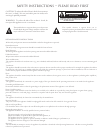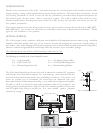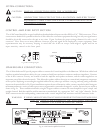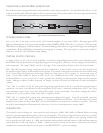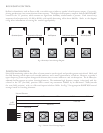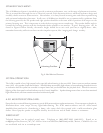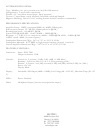
USING THE A-20 CONTROL FUNCTIONS:
POWER INDICATORS:
SYSTEM STATUS DISPLAY:
SENSITIVITY:
The A-20 controls are designed for utility and repeatability under varying conditions. You should find the effects of the
controls sonically subtle, with littleimpact on the basic character and accuracy ofthe speaker. We encourage experimentation
tofine tunethe systemtothe requirementsof yourparticular installation.
Just to the left of the power switch on the A-20 Control Amplifier are two status LED's. The upper (green) LED
lights up indicating there is AC power to the amplifier and the POWER SWITCH is in the “on”position. The lower (red)
LED indicates a clipping or overload condition. Occasional flashing of this indicator is a gentle warning you are reaching the
system’s limits. If the red LEDglows continually, severeclipping is occurring. The input signal or system gain should be
reduced to avoid the risk of possible system damage.
A unique feature of the A-20 Control Amplifier is the System Status Display located in the center of the front panel.
Small LED’s indicate which mode is being displayed; green for average SPL, yellow for AC line voltage, and blue for heat
sink temperature. The square “Mode”switch to the right of the System Status Display selects the desired mode.
SPL: This is thelong term average sound pressure level calibrated at 2 meters from a stereo pair, and derived from
the amplifier output voltage. Peak sound levels are ignored. The readout is designed to inform the user of overall listening
levels, and to help realize consistent monitoring conditions from hour to hour, session to session and room to
room. Levels under 68 dB are shown as “00”; levels over 120 dB are shown as “HI”. Since monitoring level has a
profound influence on the perception of sonics, periodically checking your listening levels helps to assure consistent
results. Making an effort to combat long term ear fatigue can help you avoid the heartbreak of harsh morning after
realities.
VAC: This is a readout of the AC power line voltage being supplied to the A-20. It is useful for assuring that power
conditions are correct and sufficient for all the equipment on the circuit. Sustained readings below 110 V may limit
your maximum output levels, and could indicate that the AC circuit is overloaded. Continuous readings above 125V
indicate an AC circuit problem, which could lead to amplifier failure.
TMP: This is a reading of the output heat sink temperature in degrees Centigrade. Typically, you should expect this
to run between 50°C and 80°C, depending on listening and ambient conditions. If you find that your Control
Amplifier unit tends to run hotter than 80°C, it is recommended that you improve the ventilation around it. Note that
the A-20Control Amplifier willautomatically shut down if the heat sink temperature reaches 100°C.
This control is used to change the input sensitivity with settings at; -10dB, -3dB, +4dB, +11dB and (M)ute providing
noise free, consistent gainmatching with a wide varietyof equipment. The proper setting is thelowest sensitivity possible
(highest dB number) which allows the speaker to reach the maximum desired output without source clipping. Professional
devices typically spec full output at +4dB, most consumer audio products reach full output at -3dB, and most computer
sound cards have a full scale output of -10dB. Consult the owner’s manual for the device connected to the Control
Amplifier forits output levelspecifications and set the SENSITIVITY control accordingly.
M
POWER
SENSITIVITY
BOUNDARY
POSITION
+11
+4
-3
-10
FF
NF
MF
0
2
1
SPL
TMP
VAC
MODE
PHONES
A-20
Control
Amplifier
100
Fig. 5 A-20 Control Amplifier Front Panel




